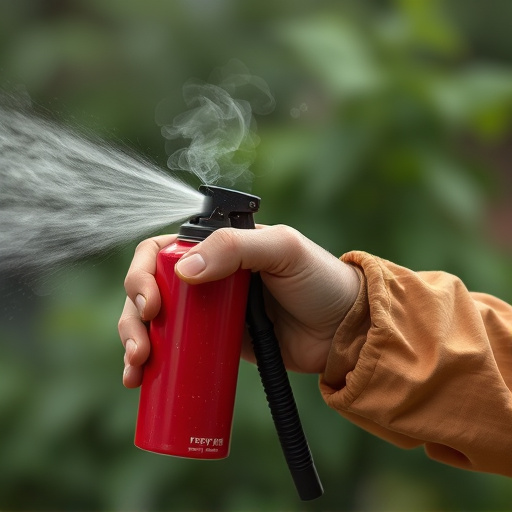Using pepper spray at home requires immediate decontamination steps to minimize its effects: evacuate to fresh air, flush affected areas with water for 15 minutes, remove contaminated clothing, clean surfaces thoroughly, and ensure proper disposal. Adhering to local laws regarding possession and use is crucial, as is understanding decontamination procedures for safety and risk prevention. Training and safe practices enhance effective self-defense with non-lethal deterrents.
“Personal security is a growing concern, leading many to seek effective non-lethal deterrent devices. This comprehensive guide explores one of the most popular options: pepper spray. We’ll delve into its basic components and how it works as a deterrence. Additionally, we cover essential decontamination steps for safe home use, legal considerations, permits, and safety training. Learn about taking control of your security while understanding the responsible use of pepper spray.”
- Understanding Non-Lethal Deterrents: A Comprehensive Overview
- Pepper Spray: The Basic Components and Functionality
- Decontamination Steps: Safely Cleaning After Use at Home
- Legal Considerations and Permits for Personal Defense Devices
- Training and Safety Measures for Effective Self-Defense
Understanding Non-Lethal Deterrents: A Comprehensive Overview
Non-lethal deterrents, like pepper spray, have gained significant attention as personal security devices. Unlike lethal force, these tools are designed to incapacitate or deter threats temporarily without causing permanent harm. Pepper spray, a common non-lethal deterrent, works by irritating the eyes and respiratory system, providing an opportunity for escape or intervention. Understanding how to properly use and decontaminate pepper spray at home is crucial for effective personal security.
The decontamination steps for pepper spray are essential to minimize its effects after use. Start by moving to a well-ventilated area immediately after exposure. Remove any contaminated clothing, wash your face with soap and water to flush out the irritants, and rinse your eyes thoroughly. Keep yourself hydrated by drinking water to help clear your respiratory system. It’s also important to dispose of used or partially used pepper spray containers responsibly, following local guidelines to prevent accidental misuse.
Pepper Spray: The Basic Components and Functionality
Pepper spray, a non-lethal deterrent, is designed to temporarily incapacitate an attacker through irritation and disorientation. Its basic components include capsaicin, a chemical derived from chili peppers, mixed with water and other additives to create a fine aerosol mist. When deployed, the spray irritates eyes, nose, and throat, reducing visibility and breathing ability.
Understanding the decontamination steps is crucial following exposure to pepper spray, especially at home. After coming into contact with the spray, immediate actions include moving to an area with fresh air, removing any contaminated clothing, and flushing affected areas like eyes and skin with plenty of water for at least 15 minutes. It’s essential to have a clear decontamination plan in place, as proper steps can significantly reduce discomfort and potential health risks associated with pepper spray exposure.
Decontamination Steps: Safely Cleaning After Use at Home
After using a pepper spray for personal security, proper decontamination steps are crucial to ensure safety and prevent any potential health risks. Start by evacuating the area and ensuring all occupants are outside or in a well-ventilated space. Next, immediately flush any affected areas with plenty of water—this includes eyes, nose, mouth, and skin. Remove any contaminated clothing and wash thoroughly with soap and water.
For surfaces, use a mixture of one part bleach to ten parts water for cleaning. Apply this solution using a cloth or sponge and allow it to sit for several minutes before wiping clean. Ensure all areas are dried properly afterward. These decontamination steps are essential, especially when dealing with pepper spray, to quickly restore a safe environment after its use.
Legal Considerations and Permits for Personal Defense Devices
When considering a non-lethal deterrent, such as pepper spray, for personal security, it’s crucial to understand the legal considerations and permits required in your region. Each area has distinct regulations regarding the possession and use of self-defense devices, with specific laws targeting pepper spray and similar products.
In many places, obtaining a permit or license is essential before purchasing and carrying pepper spray. Permits often involve background checks, training requirements, and proof of need for the device. It’s vital to research and adhere to these local regulations to ensure legal compliance. Additionally, understanding decontamination steps at home, such as proper disposal and cleaning procedures for pepper spray, is essential for safety and peace of mind.
Training and Safety Measures for Effective Self-Defense
Proper training and safety measures are essential components for effective self-defense, especially when employing non-lethal deterrents like pepper spray. Users must understand the device’s functionality, including its range, activation mechanisms, and deactivation processes. Knowing the correct usage techniques ensures that individuals can deploy the spray accurately and safely during an encounter. Regular practice sessions at home, simulating various scenarios, can help users gain confidence and proficiency in handling their personal security devices.
In addition to training, implementing decontamination steps at home is crucial for safety. Pepper spray can leave residuals on surfaces and clothing, posing potential risks if not handled properly. Users should establish a dedicated area for storing and preparing the spray, ensuring it remains accessible yet separated from living spaces. After use, proper decontamination procedures involve washing affected areas with soap and water, removing contaminated clothing, and using designated cleaning solutions to eliminate any remaining pepper spray residue. These measures safeguard users’ health and minimize the risk of accidental exposure or cross-contamination.
In conclusion, non-lethal deterrents like pepper spray offer a crucial personal security measure. By understanding their components, functionality, and safety protocols—including essential decontamination steps for home use—individuals can empower themselves to protect against potential threats while adhering to legal considerations. Proper training and safety measures are paramount to ensure these devices are effectively and responsibly utilized. Remember, knowledge is the best defense; stay prepared, stay safe.
